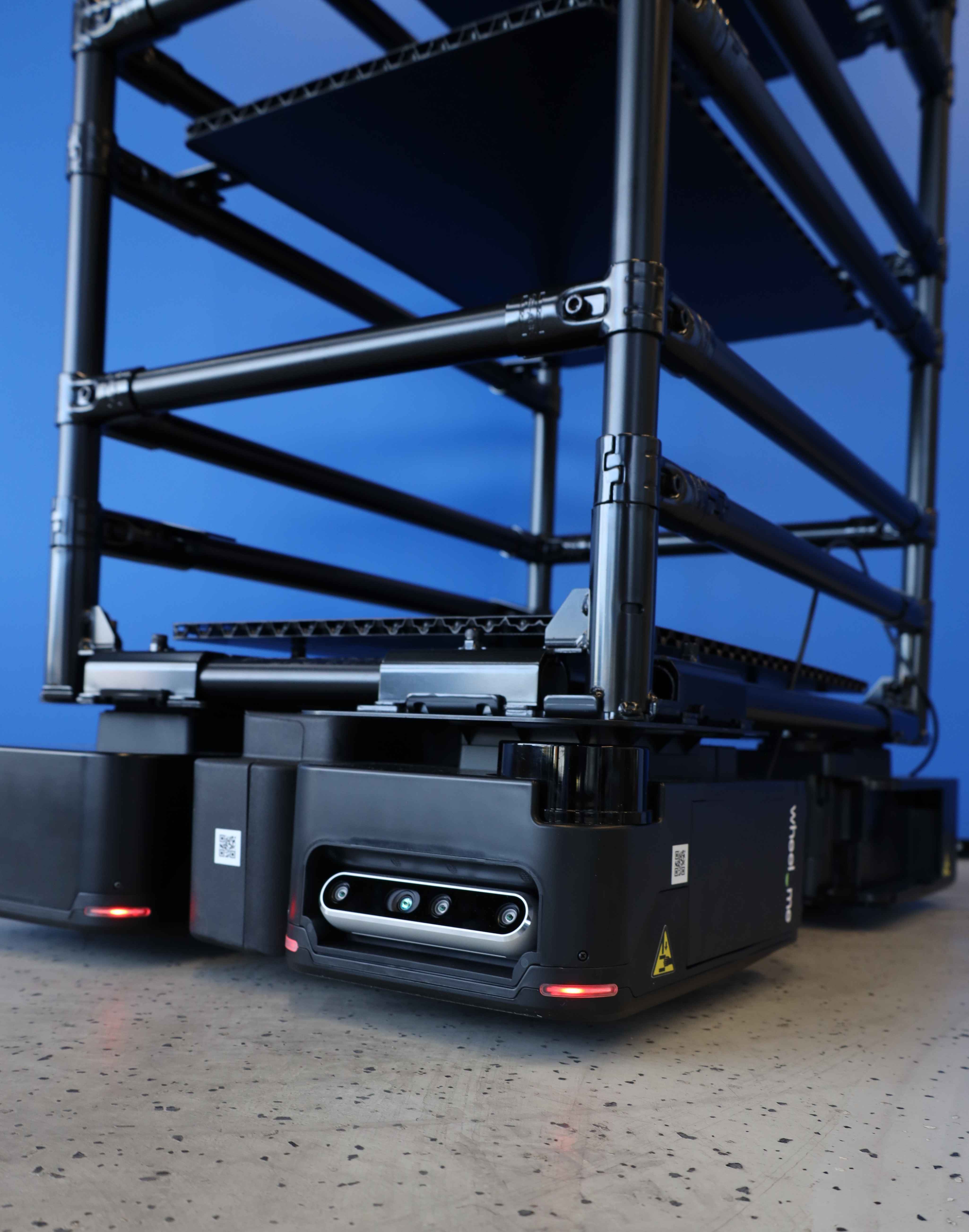Kaizen - Kaizen principle, Kaizen methods & importance for companies
In a world where markets are changing rapidly and competition is more intense than ever, organizations are looking for effective methods to remain...
Modular pipe systems
Attachments
7 min read
![]() Jens Walter
:
16.Mai.2025
Jens Walter
:
16.Mai.2025
In today’s fast-paced industrial landscape, automation, productivity, and flexibility are critical to staying competitive. Autonomous Mobile Robots (AMRs) are at the forefront of this transformation, revolutionizing robotics, material handling, and internal logistics across warehouses and production environments.
Unlike traditional systems, AMRs use real-time data and advanced sensor arrays to navigate and operate autonomously. These robots are designed to transport goods efficiently, adapt to changing workflows, and work safely alongside humans.
This article explores what AMRs are, their key advantages, and how companies like BeeWaTec, in partnership with wheel.me, are helping industries streamline operations through scalable AMR solutions. Whether you're looking to optimize payload handling, automate warehouse workflows, or deploy a collaborative fleet of mobile robots, this guide will walk you through everything you need to know.

An Autonomous Mobile Robot (AMR) is a smart, self-navigating robotic system designed to transport materials throughout a facility without relying on fixed infrastructure like tracks, magnetic tape, or floor markers. Equipped with advanced sensor technology, including LiDAR and cameras, AMRs perceive their surroundings and make decisions in real-time.
Unlike traditional Automated Guided Vehicles (AGVs), which require predefined routes, AMRs use Simultaneous Localization and Mapping (SLAM) to build and adapt a virtual environment map. This allows them to navigate autonomously, detect obstacles, and adjust their path instantly — making them ideal for dynamic warehouse and material handling operations.
Through their intelligent workflow capabilities and the integration of AI, AMRs help streamline logistics, boost productivity, and support a wide range of industrial applications. Whether handling heavy payloads or managing repetitive tasks, AMRs offer a cost-effective, user-friendly, and collaborative solution to modern automation needs.

By following this structured approach, businesses can unlock the full potential of autonomous mobile robotics, ensuring a smooth and impactful digital transformation.

BeeWaTec delivers turnkey solutions in the field of autonomous mobile robots, offering advanced systems that align with lean production and modern manufacturing and logistics requirements. In collaboration with wheel.me, a pioneer in autonomous mobility, the companies deploy scalable AMRs designed for a wide range of industries.
These autonomous mobile robotics systems are ideal for dynamic industrial settings where robots are used to streamline workflows and adapt to changing layouts. The integration supports both efficiency and flexibility, helping businesses embrace Industry 5.0 strategies.
Key Features:
By leveraging AMRs that robots can navigate intelligently, BeeWaTec and wheel.me enable businesses to modernize operations without disruption.
When selecting from the wide array of autonomous mobile robot companies, it’s essential to evaluate the following criteria to ensure the chosen solution meets operational goals. Mobile industrial robots differ in capabilities, so aligning features with your specific use case is key.
| Criteria | Considerations |
|---|---|
| Payload Capacity | Match the AMR's load-bearing capacity to your transport requirements. |
| Navigation | Choose between SLAM or QR-code navigation based on facility layout and accuracy needs. |
| Integration | Verify robots use systems compatible with existing software like WMS or ERP. |
| Floor Conditions | Consider wheel type and suspension to match surface quality and obstacles. |
| Customization | Determine if a robotic arm or custom racks/tools are necessary for the task. |
| Vendor Support | Assess availability of onboarding, training, and long-term maintenance. |
By thoroughly evaluating these areas, you can ensure a seamless integration of mobile robotic solutions that enhance productivity and reliability.
Autonomous Mobile Robots (AMRs) and Automated Guided Vehicles (AGVs) both automate material transport, but they differ greatly in terms of flexibility, intelligence, and deployment. Now, with innovations from companies like wheel.me, the next evolution of mobile robotics is already here.
Below is a feature-by-feature comparison:
| Feature | AGV | AMR | wheel.me |
|---|---|---|---|
| Navigation | Fixed paths (e.g., tape, magnets) | Dynamic navigation using sensors and maps | Autonomous navigation using LiDAR and SLAM |
| Flexibility | Low | High – adapts to changing environments | Very high – integrates with existing furniture, layouts, and workflows |
| Setup Cost | High (requires infrastructure changes) | Lower – minimal facility modifications | Extremely low – uses existing objects like chairs, carts, or shelves |
| Scalability | Limited | Easily scalable across operations | Highly scalable – modular systems support rapid deployment and expansion |
| Intelligence | Minimal – simple logic | High – real-time decision-making and obstacle avoidance | Advanced – Context-aware, assigns tasks, and optimizes workflows. |
AMRs significantly outperform AGVs in adaptive environments, making intelligent decisions that improve warehouse safety and efficiency. wheel.me takes this a step further by combining the power of AI with flexible, plug-and-play mobility—turning everyday objects into mobile, intelligent transport systems. In dynamic workflows, these autonomous robots help reduce costs, optimize payload handling, and enable smarter intralogistics across industries.
While automation technologies like AGVs and AMRs are often compared against each other, it's equally important to evaluate them against manual workflows—still common in many warehouses and production facilities. By contrasting traditional material transport methods (such as forklifts, pushcarts, or manual labor) with Autonomous Mobile Robot (AMR) handling, businesses can better appreciate the measurable improvements in efficiency, safety, and cost-effectiveness.
Below is a side-by-side comparison of Manual Handling versus AMR Handling:
| Feature | Manual Handling | AMR Handling |
|---|---|---|
| Labor Dependency | High – requires constant human input | Low – operates autonomously with minimal supervision |
| Efficiency | Inconsistent – depends on worker availability/speed | Consistent – runs continuously with optimized routing |
| Operational Cost | Higher – due to labor, injuries, and downtime | Lower – reduced labor and fewer disruptions |
| Safety | Increased risk of accidents and strain injuries | Built-in obstacle detection and safe collaboration with humans |
| Scalability | Limited by workforce capacity | Easily scalable with fleet expansion and task programming |
| Productivity | Susceptible to fatigue and human error | High – operates 24/7 without loss of performance |
| Data & Tracking | Manual logs or no tracking | Real-time tracking, task analytics, and integration with digital systems |
| Adaptability | Limited – workflow changes require retraining | Highly adaptable – AMRs adjust routes and tasks dynamically |
Why It Matters:
The transition from manual handling to AMR-supported logistics doesn't just enhance productivity—it transforms operational models. AMRs reduce reliance on manual labor for repetitive, low-value tasks, allowing human workers to focus on more strategic or skilled roles. They also improve workplace safety, support lean manufacturing, and enable smarter decision-making through data collection and integration with warehouse management systems.
By clearly understanding the delta between "before" and "after" AMR implementation, businesses can make informed decisions about modernizing their logistics workflows.

Autonomous Mobile Robots (AMRs) align perfectly with key Lean principles and tools. Below are specific ways in which AMRs help enhance lean practices:
Just-in-Time (JIT)
AMRs deliver materials and components exactly when they are needed, reducing inventory and minimizing waste. This ensures that production is not delayed and resources are used efficiently, aligning with the JIT philosophy of producing and moving only what's necessary.
5S (Sort, Set in order, Shine, Standardize, Sustain)
AMRs assist in maintaining organized, clean, and standardized workflows by automatically transporting items to the right place at the right time. This reduces clutter, keeps workstations tidy, and supports the "Sort" and "Set in order" principles.
Kaizen (Continuous Improvement)
By automating repetitive tasks and providing real-time data on material flow and bottlenecks, AMRs create opportunities for ongoing process improvements. They make it easier to implement Kaizen by enabling teams to identify inefficiencies and adjust operations continuously.
Standardized Work
AMRs follow consistent, repeatable paths, ensuring that materials and products are delivered in a predictable and reliable manner. This supports standardization in operations and helps minimize variability in production workflows.
Waste Reduction
AMRs reduce the need for manual labor in material handling and transportation, which not only cuts down on human error but also minimizes motion waste, waiting time, and overproduction.
By leveraging AMRs, manufacturers can optimize lean processes, improve efficiency, and reduce operational costs, ultimately contributing to the overall success of lean initiatives.
Autonomous Mobile Robots (AMRs) are revolutionizing the way industries transport goods and optimize manufacturing and logistics operations. With their ability to navigate dynamic environments, work collaboratively, and even integrate with a robotic arm, these robots offer a robust solution to modern intralogistics challenges. The benefits of autonomous mobile robots extend beyond productivity—enhancing worker safety, supporting complex tasks, and enabling flexible deployment of a scalable AMR fleet.
Companies like BeeWaTec, in partnership with wheel.me, are empowering businesses to harness the full potential of mobile robotics. Their innovative solutions seamlessly integrate into existing workflows, helping robots perform tasks like transporting heavy payloads or executing repetitive movements with high precision.
Whether you're starting small or scaling up, now is the time to explore the value of AMRs. Contact BeeWaTec today to discover how autonomous mobile robots can elevate your productivity, streamline your operations, and support a safer, more agile workplace.
Ready to transform your operations?
Contact BeeWaTec to explore how AMRs can elevate your productivity and efficiency.

With our modular system you can implement any solution you need. Discover your possibilities, existing solutions or build your own material flow system with BEEVisio in 3D.
In a world where markets are changing rapidly and competition is more intense than ever, organizations are looking for effective methods to remain...
At a time when companies are striving to increase efficiency and cut costs, the concept of lean management has established itself as a highly...
The material flow is an important part of every production and logistics. It describes the physical movement of materials, products and goods through...